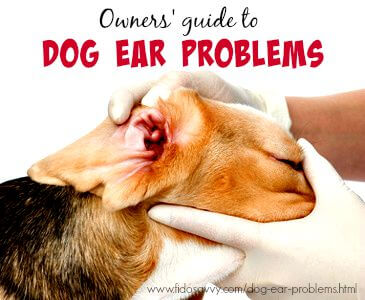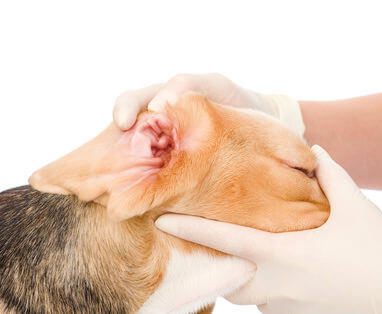FYI: If you buy something through a link on this site I may earn a commission - at NO extra cost to you.
Dog Ear Problems
Dog ear problems come in lots of different disguises.... itchy ears, inflamed ears, 'dirty' or waxy ears, lumps, injuries and more.
The majority of problems, such as dog ear infections and ear mites, are fairly simple to treat, once they're diagnosed.
Signs of trouble can vary depending on the specific type of ear trouble your puppy or dog is having. So can the treatment options.
On this page you'll find the most common causes of ear problems in dogs.
Plus a look at symptoms, treatment options and even tips for preventing future flare-ups.

Use the quick links below to jump to a specific topic/category or simply scroll down for full information...
- What causes dog ear problems?
- Symptoms of canine ear problems
- Diagnosis & treatment of dog ear infections
- Diagnosis & treatment of ear mites in dogs
- How Allergies Can Cause Dog Ear Problems
- Breed-specific canine ear problems
- Physical ear problems (eg injuries)
At the bottom of the page you will also find a link to an article on this subject, written exclusively for this website, by veterinarian Dr. Megan Teiber, DVM
Common Causes Of Dog Ear Problems
Ear issues can be 'acute' (ie sudden or one-off occurrences) or 'chronic' (ie long-term or recurring).
Here are the most common reasons for a dog to have itchy, sore or irritated ears:
Dog Ear Infections
Statistics compiled by veterinary groups and pet health insurance companies show that ear infections are one of the most common dog ear problems, and a top reason for vet visits.
Infections usually occur in the external ear canal.
Although you can usually see the redness, irritation, scabs or discharge, it's the external ear canal that is affected, not the outer 'flap' of Fidos' ear.
This condition is also called 'Otitis' or 'Otitis Externa' and can be caused by:
- Bacterial infection
- Yeast or fungal infection (can be primary or secondary infection)
- Frequent swimming or bathing
- Allergies (most likely food or seasonal allergies)
Ear infections can also be just one symptom of a more systemic disease such as Cushings' Disease or Hypothyroidism.
Dog Ear Mites
Ear mites are much more common in cats than in dogs. If you think your dog may have ear mites it's important to have your vet examine his ears because a yeast or bacterial infection is more likely and will need a different treatment approach.
There are different types of mites but the ones which cause ear problems in dogs and cats are called 'Otodectes Cynotis' mites.
This type of dog ear problem is sometimes called 'Canker Ear' and many other small pets and livestock also suffer from ear mites.
Allergies & Ear Problems in Dogs
There's a strong link between canine allergies and dog ear problems.
Irritated, itchy ears, repeated head-shaking and recurring ear infections are often a sign that your dog is having an allergic reaction to something either in his diet or his environment.
See below for symptoms & treatment of allergy-related ear issues
Breed-Specific Disposition to Ear Problems
Some dog breeds are more prone to ear problems than others.
This can either be due to a specific breeds' predisposition to health conditions which can cause ear infections (such as skin problems or allergies) as well as to the physical shape and position of the ear (eg. breeds with long, droopy ears are more at risk).
The breeds which may be more likely to experience dog ear problems include:
- Golden Retrievers
- Labrador Retrievers
- Cocker Spaniels
- Bloodhounds & other scent hounds
See below for tips on preventing ear problems in dogs with long, or hairy, ears.
Symptoms Of Dog Ear Problems
The outward symptoms of ear problems in dogs are generally similar regardless of the actual cause (or trigger).

But the visible signs can vary slightly when infection is involved, but a dogs ear with a mite problem looks different from one with an infection.
Here are the types of behavior you're likely to see if Fido is suffering from ear problems of any kind:
- Constant or repeated ear scratching
- Frequent head-shaking
- Head tilt
- Unusual 'set' of the ear
- Rubbing of ears against the carpet, furniture or doorways etc.
If not recognized and treated early enough, or if the infection is acute and severe, there are times when it travels beyond the external ear canal into the middle, or even the inner, ear canals.
This usually produces additional, more severe, symptoms which can include:
- Hearing loss
- Balance problems
- Facial nerve paralysis
- Nausea
- Dry eyes or pupil changes
Dog ear infection symptoms
Visible symptoms inside Fido's ear:
- Redness or inflammation
- Swelling
- Crusted or scabbed areas
- Discharge
- Excessive waxy build-up
- Strong, or nasty, odor
Signs that your dog may have allergies
Visible symptoms inside your dog's ear:
- Redness or inflammation
- Excessive wax
- Scabbed or crusted areas
- Discharge
* When allergies are the root cause of dog ear problems, the symptoms (as shown above )may be cyclic (regularly occur at a particular time of year) which would indicate a seasonal allergy.
Or they can be chronic (pretty much constant) which could mean that a food allergy is the issue.
An allergy to flea saliva can also result in itchy, inflamed ears and cause infection.
Symptoms of dog ear mites
Visible symptoms inside the ear:
- Dark brown or black 'gunk' in the ear canal which can extend to the outer ear area
- Redness or inflammation
- Crusted or scabbed areas inside the ear flaps
- Strong odor
Diagnosis & Treatment Of Dog Ear Infections
Diagnosis of Dog Ear Infections
If Fido is showing signs of an ear infection it's important to have your veterinarian examine his ears.
HELPFUL TIP....
Don't clean out your dogs' ears before you take him to your vet for an exam.
The vet needs to see what's happening in there!
The treatment options will vary depending on whether the infection is bacterial or fungal and only your veterinarian can make an accurate diagnosis.
Ear infections can be really painful (as you'll know if you, or one of your children has ever suffered from one!), so getting treatment asap is a priority.
Treating Dog Ear Infections
If this is the first time that your dog has had ear problems then a vet visit is essential because you can't treat the ear properly until you know what's causing the problem!
There are four common types of bacteria (including Staph) which can cause canine ear infections, plus the yeast Malassesia.
Your veterinarian will be able to run tests which will identify the specific type of infection and prescribe an antibiotic (for bacterial infections) or an anti-fungal (for yeast infections).
Corticosteroids are sometimes necessary if the inflammation is severe or Fidos' ear is swollen.
Some products combine both steroid and antibiotic/anti-fungal.
Generally dog ear medicines come in topical/liquid form, either as drops (or in a pump-dispenser) or as an ointment.

Oral antibiotics or other oral meds can also be prescribed for severe, or more systemic, infections.
Popular dog ear medicines for treating ear infection in dogs include (but aren't limited to):
- EasOtic (Topical Liquid)
- Zymox (Liquid with hydrocortisone)
- Posatex (Drops or Ointment)
- Mometamax (Drops)
- Tresaderm (Drops)
- Baytril (Oral)
- Cephalosporin Antibiotics (Oral)
- Corticosteroids such as Prednisone Or Atopica (Cylclosporin medication)
- Antihistamines (for allergy-related ear infections)
Once your veterinarian has taken swabs/cultures from your dogs ears and identified the problem he/she will usually clean the ears gently and then apply whatever medication is the best choice.
You'll need to continue the treatment at home, sometimes for only 5 - 10 days, other times it can take weeks for the infection to be fully eliminated.
Your vet will give you instructions and it's important to follow them closely and to FINISH all medications if told to do so. Stopping antibiotics early can lead to resistant infection.
If you have had your dog examined by your veterinarian previously for ear infections and he has a minor recurrence of the problem, there's an OTC product (non-prescription) which may help.
It's called Zymox Otic and contains natural enzymes as well as 1% hydrocortisone. Zymox has both antibacterial (but is NOT an antibiotic) and antifungal properties.
If you'd like to follow a natural route to treat your dog's ear infection you could try EcoEars.
EcoEars is an ear cleaner which contains a blend of all natural, organic ingredients with naturally disinfecting and antimicrobial properties.
It can reduce itching, pain and discharge gently and quickly.
Also suitable to use for dogs with yeast ear problems and ear mites.
Previous veterinary beliefs were that yeast infections in dogs could be triggered by diet (too much grain or sugar), however that is no longer the case and many veterinarians no longer subscribe to this theory.
This is what Dr. Megan Teiber shared with me on this subject:
Yeast is considered an opportunistic infection - meaning yeast is ubiquitous in the environment and most dogs can eliminate yeast from the ear with no problem.
However if the skin’s normal defenses are disrupted by allergies or conformational abnormalities, the yeast takes over and infection becomes established.
This is true of bacterial ear infections too.
Food allergies are a big reason a dog becomes prone to infection, but grains are rarely the culprit in food allergies.
So basically, most healthy dogs will not experience dog ear problems which are due to the presence of yeast.
BUT, dogs who have allergies, compromised immune systems, physical abnormalities of their ears or are unwell, stressed or generally below-par in terms of health, are less able to handle any yeast and infection can take hold.
Once the initial infection has been treated by your veterinarian, feeding a grain-free diet and adding probiotics can help control the yeast and prevent future recurrences in susceptible dogs.
If Fidos' ear infection is caused by allergies then treating the initial (and secondary) infection won't make the problem go away permanently.
When allergies are involved in your dogs' ear problems, then it's vital to find the allergy trigger and eliminate it if at all possible.
When a food ingredient is to blame, a dietary change can make all the difference.
Check out this page for the information and advice you need to deal with food-related allergies in dogs... All About Dog Food Allergies
Seasonal allergies are more difficult to deal with but oral antihistamines or even allergy shots can reduce your dogs reaction to the allergen and stop the resulting infections.
Learn more about the causes, symptoms and treatment of canine skin allergies here.
Surgery For Ear Infections?
If your dog has recurring, severe ear infections that don't respond to medication, your veterinarian may recommend sedating your dog and 'flushing' his ear canals, or even ear-canal ablation surgery.
Diagnosis & Treatment Of Ear Mites
Diagnosis
Along with intense itching and often sore, red ears, a dog with ear mites usually has visible evidence of these little parasites.... black/brown crusty discharge or debris.
It can almost look as though there are coffee-grounds deep in the ear canal.
Because these nasty little critters burrow into your dogs' tender skin to lay their eggs, and the surrounding tissue/ear flaps are likely to be red or irritated.
A visual inspection by your vet is usually enough to tell him that mites are your dog's ear problems, but he will follow up by removing some of the debris and examining it under a microscope to be certain.

There are different types of mites, and some fairly common ones such as Demodex or Sarcoptic mites (which cause Mange) can cause ear problems but actually affect your dogs' whole body -and so a more systemic treatment is needed.
It's sometimes possible to do an 'at-home' ear mite test on your own pet if you have a fairly strong magnifying glass (or obviously a microscope would be better if you have one!).
You can gently swab your dogs ear to remove some of the crusty debris, and put it onto a clean piece of paper, then examine it closely through the magnification.
Ear mites will show up against the dark debris as tiny, moving white dots. BUT just because you don't see any, doesn't mean that your pet is mite-free.
Your vet has better equipment and more experience and is the best person to make the diagnosis!
Treating Dog Ear Mites
The most effective treatment for dog ear problems caused by mites are Ivermectin-based products.
Ivermectin Warning!
There are certain breeds who should never be given Ivermectin due to a particular over-sensitivity. These include herding dogs of all kinds, herding dog mixes & white German Shepherds. Older or elderly dogs can also be at risk.
Your vet will first clean out Fidos' ears gently and carefully, most likely using a mineral-oil based solution, and then apply the topical treatment.
Some medications only need to applied once, others will need follow up treatments either at home, or at the veterinary clinic.
Depending on how severe the problem is, your vet may prescribe antibiotics, anti-inflammatory medications, corticosteroids and/or topical ivermectin products (such as Advantage Multi or Revolution products usually used for flea/tick control) as these are also somewhat effective against mites.
Posatex, Zymox, Otomite Plus, Milbemite, Eradimite and other products are all commonly used.
Once your dog has been diagnosed with ear mites and been treated by your vet, you will be in a better position to recognize any future problems.
The following products can be bought without a prescription and can be effective in treating, and preventing, further earmite infestations...
Preventing Breed-Specific Dog Ear Problems
If you own a dog with long, floppy ears such as a Bloodhound, Basset Hound, Spaniel etc., he/she has an above-average chance of developing ear problems.
This is due to both the shape of the ear, whose weight and position forms a warm, moist and enclosed area for infection/mites to inhabit.
Some dogs also have a tendency to grow hair deep inside their ears, and these also produce a warm, moist (and protected) environment where bacteria, yeast or mites can flourish.
Dogs who spend a lot of time in the water (hunting/retrieving dogs or just those who love to swim!) are also at higher risk of developing ear infections due to the inside of their ears being moist for long periods.
So, what can you do to prevent ear infections in dogs like these?
Here are a few tips:
Keep those ears dry inside
If Fido has been swimming, be sure to dry his ears gently every time he comes inside.
Don't poke or prod and use soft cotton balls or pads, or a soft (and thin) hand towel or kitchen towel.
As long as you know your dogs ears are otherwise healthy (no punctured ear-drums for example) you can use the doggie-version of SwimEar such as Vedco Swimmer's Ear after his ears are dry.
Also, clean his ears gently at least every two or three weeks whenever he's swimming regularly.
Use a gentle cleaner such as Nutri Vet Ear Cleanse or gentle ear wipes such as Earthbath All Natural Dog Ear Wipes.
When you bathe your puppy or dog, put some wadded cotton wool gently into the outer part of her ear - don't push it in there.
This will help keep shampoo and water out of he delicate ear canal. Don't forget to remove them when bath-time is over!
Find out how to bathe a puppy (or a dog, the process is the same) here... Bathing A Puppy.
Keep Fidos' ears clear of hair, moisture and debris
Dogs with long, floppy ears find it very easy to get stuff stuck on, and in, them.

After your dog has been outdoors always check his outer ear for burrs, seeds, sticks and so on, check the inside too. It's amazing how stuff just creeps in there.
Clean heavy, long, floppy or hairy dog ears bi-weekly with the same type of gentle cleaners mentioned above.
This helps to prevent any infections taking hold. Always dry the ears properly, and carefully, after cleaning.
Keep the hair on long, floppy ears short, and trimmed neatly around the edges.
If Fido has hairs growing inside the ear canal which are collecting wax or debris, ask your groomer to pluck them carefully.
It's not necessary to do this for a few hairs, and can cause more problems than it solves in those cases, but if the hair is thick or is trapping moisture, wax and other stuff, then they need to go.
Physical Dog Ear Problems
Finally, there's an 'open-category' for injuries and conditions that affect your dogs' ears.This isn't a big group!
Dogs with ear infections or mites can cut or injure the skin in and around the ear and cause bleeding.
Obviously treating the underlying infection is the #1 task, but it's also important to keep any scratches/cuts clean and watch for signs of infection (including swelling, redness, heat or pus).
Itchy ears are intensely irritating for Fido, and frequent head shaking is common.
Occasionally your dog will shake his head so violently that he actually breaks a blood-vessel (or two) in his ear flap/s.
This often causes a dog ear hematoma when part of the ear flap can fills up with blood and ends up looking quite swollen and strange.
If this happens take your dog to your veterinarian as the blood may need to be drained. In severe cases of ear hematomas in dogs surgery is needed to correct the problem.
Although the collection of blood may be reabsorbed into the ear if over time if left alone, it's a very painful condition for your dog to endure.
When a hematoma isn't treated properly Fido is likely to end up with 'Cauliflower ear', yes the same thing boxers have happen to their ears! This is unsightly and uncomfortable.
Bug bites or stings, can cause swelling (sometimes pretty severe swelling) at the site of the trauma.
An allergic reaction can cause swelling of the head, face, muzzle and sometimes the ears as well.
The head shaking and ear scratching of a dog with allergies affecting his ears can also cause a hematoma to develop.
This type of reaction can be serious and you need to have your pup/dog seen by your vet if it happens.
CLICK HERE to read an article about dog ear problems, written specifically for this website by veterinarian Dr. Megan Teiber, DVM.
For your peace of mind, puppy and dog health information on this site has been approved by veterinarian Dr. Megan Teiber, DVM
- Home
- Dog Health Information
- Dog Ear Problems
FTC Disclosure: Some pages on this site contain affiliate links. I may earn on qualified purchases.











